The global low molecular weight chondroitin sulfate sodium market is projected to rise from USD 37.8 million in 2025 to USD 55.9 million by 2035, advancing at a CAGR of 4.0% and recording a total growth of 47.9%. The low molecular weight chondroitin sulfate sodium market size is expected to expand by nearly 1.48X during the forecast period, shaped by production scalability, evolving demand in healthcare and nutraceutical sectors, and supply-side adjustments across global regions.
Production dynamics are heavily influenced by sourcing and extraction methods. Chondroitin sulfate is derived primarily from bovine, porcine, poultry, and marine cartilage, with low molecular weight forms requiring specialized enzymatic hydrolysis or chemical modification to improve bioavailability. Producers face cost pressures due to complex purification and molecular weight reduction processes, which increase operational expenses compared with conventional chondroitin. Manufacturing hubs are concentrated in Asia, particularly China and India, where raw material availability and cost-effective labor support production. European and North American facilities emphasize pharmaceutical-grade output with tighter quality control. Production scalability is limited by both raw material constraints and the need for compliance with stringent GMP standards, which elevate entry barriers for new players.
Demand dynamics are shaped by multiple end-use segments. Nutraceutical applications dominate, as low molecular weight chondroitin is preferred for joint health supplements due to superior absorption rates and bioefficacy. The aging global population, combined with rising prevalence of osteoarthritis and degenerative joint conditions, underpins consistent demand growth in North America, Europe, and East Asia. Pharmaceutical applications are expanding as manufacturers integrate low molecular weight derivatives into prescription-grade formulations, particularly in markets emphasizing evidence-based therapies for cartilage repair. Functional food and beverage development is another emerging demand driver, as brands incorporate bioavailable chondroitin into fortified products targeted at wellness-focused consumers. Regional demand imbalances are notable: Asia Pacific leads volume consumption through dietary supplements, Europe emphasizes regulated pharmaceutical applications, and North America balances both healthcare and consumer-driven nutraceutical demand.
Supply dynamics reflect a fragmented yet regionally concentrated structure. The supply of raw materials depends heavily on livestock and marine byproduct availability, which introduces volatility tied to global meat processing trends and fisheries output. Supply risks also arise from disease outbreaks affecting livestock, trade restrictions, or environmental regulations impacting marine resource extraction. Producers with backward integration into cartilage sourcing or partnerships with meat processors enjoy cost stability, while smaller suppliers face exposure to raw material price fluctuations. Logistics and regulatory compliance further shape supply availability: in Europe, strict approval processes slow imports, while Asia benefits from faster commercialization but faces scrutiny regarding product traceability and purity.
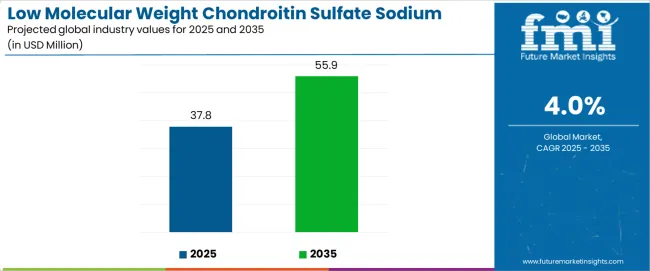
Between 2025 and 2030, the low molecular weight chondroitin sulfate sodium market is projected to expand from USD 37.8 million to USD 46.5 million, resulting in a value increase of USD 8.7 million, which represents 48.1% of the total forecast growth for the decade. This phase of development will be shaped by increasing pharmaceutical research into low molecular weight derivatives, rising adoption of specialized manufacturing processes, and growing demand for enhanced bioavailability formulations with improved absorption characteristics. Healthcare providers are expanding their sourcing capabilities to address the growing demand for high-purity chondroitin derivatives, specialized pharmaceutical applications, and advanced nutraceutical product development requirements.
| Metric | Value |
|---|---|
| Estimated Value in 2025 (USD) | 37.8 million |
| Forecast Value in 2035 (USD) | 55.9 million |
| Forecast CAGR (2025-2035) | 4.0% |
From 2030 to 2035, the low molecular weight chondroitin sulfate sodium market is forecast to grow from USD 46.5 million to USD 55.9 million, adding another USD 9.4 million, which constitutes 51.9% of the overall ten-year expansion. This period is expected to be characterized by the expansion of advanced purification technologies, the integration of novel extraction methodologies, and the development of specialized formulation techniques with maintained bioactivity performance. The growing adoption of pharmaceutical-grade manufacturing processes will drive demand for low molecular weight chondroitin sulfate sodium with superior purity levels and compatibility with advanced drug delivery systems across research institutions.
Between 2020 and 2025, the low molecular weight chondroitin sulfate sodium market experienced steady growth, driven by increasing demand for specialized joint health ingredients and growing recognition of low molecular weight derivatives as essential components for enhanced bioavailability in pharmaceutical and nutraceutical applications. The low molecular weight chondroitin sulfate sodium market developed as manufacturers recognized the potential for low molecular weight formulations to improve absorption rates while maintaining therapeutic efficacy and enabling advanced dosage formats. Technological advancement in enzymatic degradation processes and molecular weight control methodologies began emphasizing the critical importance of maintaining bioactivity and structural integrity in specialized pharmaceutical environments.
Market expansion is being supported by the increasing global demand for specialized nutraceutical ingredients and the corresponding need for highly bioavailable compounds that can provide superior absorption characteristics and enhanced therapeutic efficacy while enabling targeted pharmaceutical applications and advanced functional food development across various healthcare and wellness distribution segments. Modern pharmaceutical manufacturers and nutraceutical producers are increasingly focused on implementing specialized ingredients that can deliver enhanced bioavailability, enable efficient absorption, and provide consistent therapeutic performance throughout complex formulation and manufacturing processes. Low molecular weight chondroitin sulfate sodium's proven ability to deliver exceptional bioavailability against traditional formulations, enable enhanced cellular uptake, and support targeted therapeutic applications make them essential ingredients for contemporary pharmaceutical research and advanced nutraceutical development operations.
The growing emphasis on bioavailability enhancement and therapeutic efficiency is driving demand for low molecular weight chondroitin derivatives that can support specialized pharmaceutical requirements, improve therapeutic outcomes, and enable advanced formulation formats. Manufacturers' preference for ingredients that combine enhanced absorption with processing stability and therapeutic efficacy is creating opportunities for innovative low molecular weight implementations. The rising influence of personalized medicine and targeted therapeutic approaches is also contributing to increased demand for chondroitin derivatives that can provide enhanced bioavailability, improved cellular targeting, and reliable performance across specialized pharmaceutical applications.
The low molecular weight chondroitin sulfate sodium market is poised for steady growth and specialization. As industries across pharmaceuticals, nutraceuticals, functional foods, cosmetics, and healthcare seek ingredients that deliver exceptional bioavailability, enhanced absorption, and therapeutic convenience, low molecular weight chondroitin derivatives are gaining prominence not just as commodity ingredients but as strategic enablers of therapeutic efficacy and patient satisfaction.
Rising pharmaceutical research penetration in Asia-Pacific and expanding nutraceutical markets globally amplify demand, while manufacturers are leveraging innovations in enzymatic degradation processes, molecular weight control systems, and specialized purification methodologies.
Pathways like pharmaceutical-grade formulations, specialized cosmetic applications, and therapeutic customization promise strong margin uplift, especially in high-value segments. Geographic expansion and vertical integration will capture volume, particularly where local manufacturing capabilities and regulatory compliance proximity are critical. Regulatory pressures around ingredient purity standards, bioavailability requirements, therapeutic efficacy validation, and quality assurance protocols give structural support.
The low molecular weight chondroitin sulfate sodium market is segmented by molecular weight, application, purity grade, source type, end-use industry, and region. By molecular weight, the market is divided into <5kDa, 5-15kDa, and others. By application, it covers medicine, health products, cosmetics, and others. By purity grade, the low molecular weight chondroitin sulfate sodium market is segmented into pharmaceutical grade (>98%), food grade (95-98%), and industrial grade (<95%). The source type includes marine-derived, synthetic, and hybrid sources. By end-use industry, it is categorized into pharmaceuticals, nutraceuticals, cosmetics & personal care, research institutions, and others. Regionally, the low molecular weight chondroitin sulfate sodium market is divided into North America, Europe, East Asia, South Asia & Pacific, Latin America, and the Middle East & Africa.
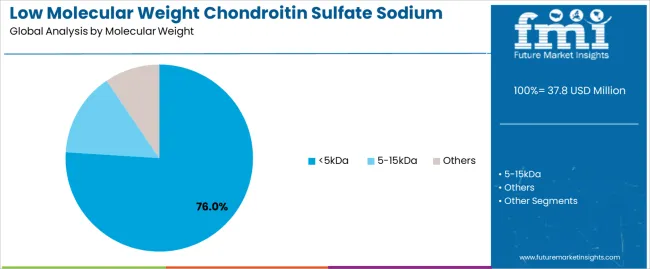
The <5kDa molecular weight segment is projected to account for 76% of the low molecular weight chondroitin sulfate sodium market in 2025, reaffirming its position as the leading category. Pharmaceutical manufacturers and nutraceutical producers increasingly utilize <5kDa chondroitin derivatives for their superior bioavailability properties when processed through specialized enzymatic degradation technologies, excellent absorption characteristics, and therapeutic effectiveness in applications ranging from joint health supplements to specialized pharmaceutical formulations. <5kDa chondroitin sulfate sodium technology's advanced cellular uptake capabilities and consistent molecular structure directly address the pharmaceutical requirements for reliable therapeutic efficacy in specialized healthcare environments.
This molecular weight segment forms the foundation of modern pharmaceutical ingredient operations, as it represents the chondroitin type with the greatest bioavailability and established therapeutic demand across multiple application categories and industry sectors. Manufacturer investments in enhanced purification technologies and pharmaceutical-grade processing compatibility continue to strengthen adoption among pharmaceutical companies and nutraceutical producers. With companies prioritizing therapeutic efficacy and bioavailability optimization, <5kDa chondroitin derivatives align with both therapeutic performance requirements and regulatory compliance objectives, making them the central component of comprehensive pharmaceutical strategies.
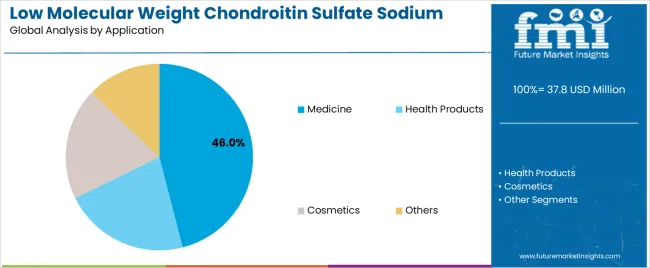
Medicine applications are projected to represent 46% of low molecular weight chondroitin sulfate sodium demand in 2025, underscoring their critical role as the primary industrial consumers of specialized chondroitin derivatives for pharmaceutical development, clinical research, and therapeutic product manufacturing. Pharmaceutical operators prefer low molecular weight formulations for their exceptional bioavailability capabilities, enhanced absorption characteristics, and ability to provide therapeutic efficacy while ensuring patient compliance with effective treatments. Positioned as essential ingredients for modern pharmaceutical operations, low molecular weight chondroitin offers both therapeutic advantages and formulation benefits.
The segment is supported by continuous innovation in pharmaceutical processing technologies and the growing availability of specialized molecular structures that enable enhanced bioactivity with improved stability performance and rapid therapeutic onset. Additionally, pharmaceutical operators are investing in advanced manufacturing systems to support large-scale low molecular weight chondroitin utilization and formulation efficiency. As personalized medicine demand becomes more prevalent and therapeutic specificity increases, medicine applications will continue to dominate the end-use market while supporting advanced pharmaceutical utilization and research development strategies.
The low molecular weight chondroitin sulfate sodium market is advancing steadily due to increasing demand for enhanced bioavailability ingredients and growing adoption of specialized pharmaceutical compounds that provide superior absorption characteristics and therapeutic efficacy while enabling targeted drug delivery across diverse pharmaceutical and nutraceutical development applications. The low molecular weight chondroitin sulfate sodium market faces challenges, including complex manufacturing processes, regulatory compliance requirements, and the need for specialized purification technology investments. Innovation in enzymatic processing methodologies and advanced purification techniques continues to influence product development and market expansion patterns.
The growing adoption of pharmaceutical-grade manufacturing processes, advanced molecular weight control systems, and specialized purification methodologies is enabling manufacturers to produce high-purity low molecular weight chondroitin with superior bioactivity, enhanced stability properties, and validated therapeutic performance functionalities. Advanced purification systems provide improved pharmaceutical compliance while allowing more efficient research applications and consistent performance across various therapeutic conditions and formulations. Manufacturers are increasingly recognizing the competitive advantages of pharmaceutical-grade capabilities for product differentiation and premium market positioning.
Modern low molecular weight chondroitin producers are incorporating automated purification systems, integrated quality control equipment, and sensor-controlled molecular weight monitoring mechanisms to enhance manufacturing precision, enable cost optimization, and deliver value-added solutions to pharmaceutical and research customers. These technologies improve production throughput while enabling new operational capabilities, including high-precision molecular weight control, consistent purity standards, and reduced manufacturing waste. Advanced automation integration also allows manufacturers to support large-scale pharmaceutical operations and research facility modernization beyond traditional manual processing approaches.
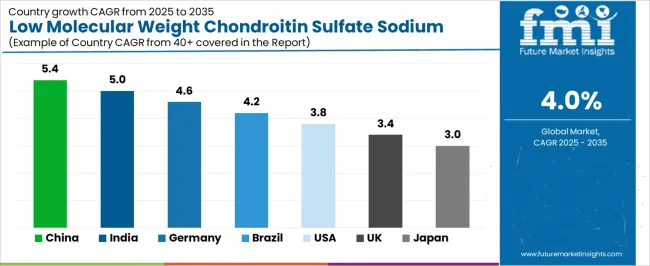
| Country | CAGR (2025-2035) |
|---|---|
| China | 5.4% |
| India | 5.0% |
| Germany | 4.6% |
| Brazil | 4.2% |
| USA | 3.8% |
| United Kingdom | 3.4% |
| Japan | 3.0% |
The low molecular weight chondroitin sulfate sodium market is experiencing moderate growth globally, with China leading at a 5.4% CAGR through 2035, driven by the expanding pharmaceutical manufacturing sector, growing nutraceutical ingredient production, and significant investment in biotechnology research development. India follows at 5.0%, supported by rapid pharmaceutical industry growth, increasing healthcare ingredient demand, and growing domestic research capabilities.
Germany shows growth at 4.6%, emphasizing pharmaceutical innovation and advanced manufacturing development. Brazil records 4.2%, focusing on nutraceutical market expansion and healthcare ingredient production. The USA demonstrates 3.8% growth, prioritizing pharmaceutical research excellence and therapeutic ingredient innovation. The United Kingdom exhibits 3.4% growth, emphasizing precision manufacturing and quality pharmaceutical ingredient production. Japan shows 3.0% growth, supported by advanced biotechnology research and pharmaceutical ingredient development.
The report covers an in-depth analysis of 40+ countries, with top-performing countries highlighted below.
Revenue from low molecular weight chondroitin sulfate sodium in China is projected to exhibit strong growth with a CAGR of 5.4% through 2035, driven by expanding pharmaceutical manufacturing capabilities and rapidly growing biotechnology research supported by government initiatives promoting advanced healthcare ingredient development. The country's strong position in chemical manufacturing and increasing investment in pharmaceutical infrastructure are creating substantial demand for specialized chondroitin derivatives. Major pharmaceutical companies and research institutions are establishing comprehensive sourcing capabilities to serve both domestic pharmaceutical demand and international export markets.
Demand for low molecular weight chondroitin sulfate sodium in India is expanding at a CAGR of 5.0%, supported by the country's growing pharmaceutical industry, expanding nutraceutical sector, and increasing adoption of specialized healthcare ingredients. The country's government initiatives promoting pharmaceutical manufacturing and growing healthcare awareness are driving requirements for high-quality therapeutic ingredients. International suppliers and domestic manufacturers are establishing extensive production and distribution capabilities to address the growing demand for pharmaceutical-grade chondroitin products.
Revenue from low molecular weight chondroitin sulfate sodium in Germany is expanding at a CAGR of 4.6%, supported by the country's advanced pharmaceutical research capabilities, strong emphasis on biotechnology innovation, and robust demand for high-performance therapeutic ingredients in pharmaceutical and research applications. The nation's mature pharmaceutical sector and quality-focused operations are driving sophisticated manufacturing systems throughout the supply chain. Leading manufacturers and research institutions are investing extensively in purification equipment and advanced processing technologies to serve both domestic and international markets.
Demand for molecular weight chondroitin sulfate sodium in Brazil is growing at a CAGR of 4.2%, driven by the country's expanding nutraceutical sector, growing healthcare ingredient market, and increasing investment in pharmaceutical infrastructure development. Brazil's large consumer base and commitment to healthcare expansion are supporting demand for specialized chondroitin derivatives across multiple therapeutic segments. Manufacturers are establishing comprehensive production capabilities to serve the growing domestic market and regional export opportunities.
Revenue from low molecular weight chondroitin sulfate sodium in the USA is expanding at a CAGR of 3.8%, supported by the country's pharmaceutical research leadership, advanced biotechnology capabilities, and strategic focus on high-performance therapeutic ingredients. The USA's research excellence and pharmaceutical innovation are driving demand for chondroitin derivatives in pharmaceutical development, clinical research, and specialized therapeutic applications. Manufacturers are investing in comprehensive research capabilities to serve both domestic pharmaceutical companies and international specialty markets.
Demand for low molecular weight chondroitin sulfate sodium in the United Kingdom is growing at a CAGR of 3.4%, driven by the country's expertise in pharmaceutical research, emphasis on quality control, and strong position in biotechnology and specialty ingredient development. The UK's established pharmaceutical technology capabilities and commitment to research excellence are supporting investment in advanced production technologies throughout major research centers. Industry leaders are establishing comprehensive quality assurance systems to serve domestic pharmaceutical manufacturers and international research institutions.
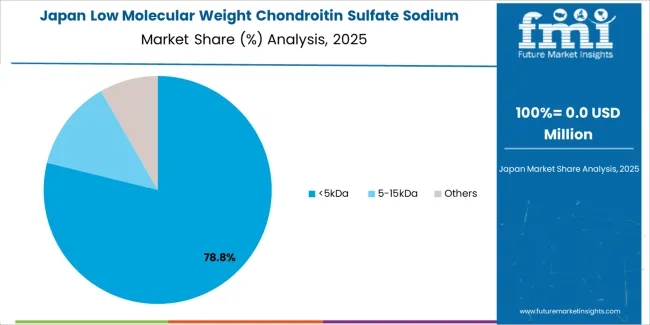
Revenue from low molecular weight chondroitin sulfate sodium in Japan is expanding at a CAGR of 3.0%, supported by the country's advanced pharmaceutical research concentration, growing biotechnology sector, and strategic position in specialized ingredient manufacturing. Japan's precision manufacturing capabilities and integrated research infrastructure are driving demand for high-quality chondroitin derivatives in pharmaceutical research, therapeutic development, and specialty healthcare applications. Leading manufacturers are investing in specialized capabilities to serve the stringent requirements of pharmaceutical and research industries.
The low molecular weight chondroitin sulfate sodium market in Europe is projected to grow from USD 8.7 million in 2025 to USD 12.8 million by 2035, registering a CAGR of 3.9% over the forecast period. Germany is expected to maintain its leadership position with a 28.5% market share in 2025, declining slightly to 28.0% by 2035, supported by its strong pharmaceutical industry, advanced biotechnology research capabilities, and comprehensive pharmaceutical manufacturing sector serving diverse chondroitin applications across Europe.
United Kingdom follows with a 22. % share in 2025, projected to reach 22.5% by 2035, driven by robust demand for chondroitin derivatives in pharmaceutical research, biotechnology development, and specialized therapeutic applications, combined with established research infrastructure and pharmaceutical expertise. France holds an 18.5% share in 2025, expected to reach 19.0% by 2035, supported by strong pharmaceutical market and growing biotechnology activities.
Italy commands a 14.0% share in 2025, projected to reach 14.2% by 2035, while Spain accounts for 8.0% in 2025, expected to reach 8.3% by 2035. The Netherlands maintains a 4.5% share in 2025, growing to 4.8% by 2035. The Rest of Europe region, including Nordic countries, Eastern Europe, Belgium, Poland, and other nations, is anticipated to maintain momentum, with its collective share moving from 4.5% to 3.2% by 2035, attributed to increasing pharmaceutical research in Eastern Europe and growing biotechnology penetration in Nordic countries implementing advanced therapeutic ingredient programs.
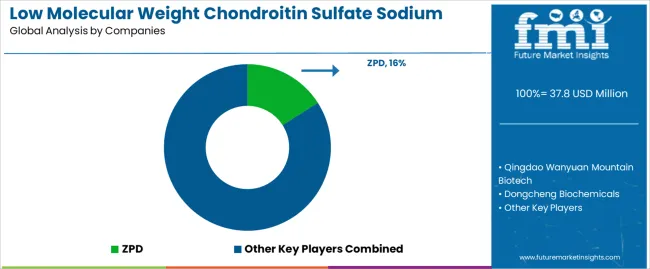
The low molecular weight chondroitin sulfate sodium market is characterized by competition among established pharmaceutical ingredient manufacturers, specialized biotechnology companies, and integrated healthcare ingredient producers. Companies are investing in enzymatic processing research, molecular weight optimization, purification system development, and comprehensive product portfolios to deliver consistent, high-performance, and application-specific chondroitin derivatives. Innovation in pharmaceutical-grade manufacturing, advanced purification integration, and bioactivity validation is central to strengthening market position and competitive advantage.
ZPD leads the low molecular weight chondroitin sulfate sodium market with a strong market share, offering comprehensive chondroitin sulfate solutions with a focus on pharmaceutical and research applications. Qingdao Wanyuan Mountain Biotech provides specialized marine-derived ingredients with an emphasis on high-purity formulations and customized molecular weights. Dongcheng Biochemicals delivers innovative pharmaceutical ingredients with a focus on advanced purification and quality assurance. Jiaxing Nudikon Lifescience specializes in biotechnology-based production and advanced manufacturing processes for pharmaceutical applications. Shandong Topscience Biotech focuses on research-grade materials and specialized pharmaceutical ingredient development. HS Nutra offers specialized nutraceutical ingredients with emphasis on bioavailability and therapeutic applications.
| Item | Values |
|---|---|
| Quantitative Units (2025) | USD 37.8 million |
| Molecular Weight | <5kDa, 5-15kDa, Others |
| Application | Medicine, Health Products, Cosmetics, Others |
| Purity Grade | Pharmaceutical Grade (>98%), Food Grade (95-98%), Industrial Grade (<95%) |
| Source Type | Marine-Derived, Synthetic, Hybrid Sources |
| End-Use | Pharmaceuticals, Nutraceuticals, Cosmetics & Personal Care, Research Institutions, Others |
| Regions | North America, Europe, East Asia, South Asia & Pacific, Latin America, Middle East & Africa |
| Countries | United States, Canada, United Kingdom, Germany, France, China, Japan, South Korea, India, Brazil, Australia, and 40+ countries |
| Key Companies | ZPD, Qingdao Wanyuan Mountain Biotech, Dongcheng Biochemicals, Jiaxing Nudikon Lifescience, Shandong Topscience Biotech, HS Nutra |
| Additional Notes | Dollar sales by molecular weight and application category, regional demand trends, competitive landscape, technological advancements in enzymatic processing systems, molecular weight control development, purification equipment innovation, and pharmaceutical supply chain integration |
The global low molecular weight chondroitin sulfate sodium market is estimated to be valued at USD 37.8 million in 2025.
The market size for the low molecular weight chondroitin sulfate sodium market is projected to reach USD 55.9 million by 2035.
The low molecular weight chondroitin sulfate sodium market is expected to grow at a 4.0% CAGR between 2025 and 2035.
The key product types in low molecular weight chondroitin sulfate sodium market are <5kda , 5-15kda and others.
In terms of application, medicine segment to command 46.0% share in the low molecular weight chondroitin sulfate sodium market in 2025.






Our Research Products

The "Full Research Suite" delivers actionable market intel, deep dives on markets or technologies, so clients act faster, cut risk, and unlock growth.

The Leaderboard benchmarks and ranks top vendors, classifying them as Established Leaders, Leading Challengers, or Disruptors & Challengers.

Locates where complements amplify value and substitutes erode it, forecasting net impact by horizon

We deliver granular, decision-grade intel: market sizing, 5-year forecasts, pricing, adoption, usage, revenue, and operational KPIs—plus competitor tracking, regulation, and value chains—across 60 countries broadly.

Spot the shifts before they hit your P&L. We track inflection points, adoption curves, pricing moves, and ecosystem plays to show where demand is heading, why it is changing, and what to do next across high-growth markets and disruptive tech

Real-time reads of user behavior. We track shifting priorities, perceptions of today’s and next-gen services, and provider experience, then pace how fast tech moves from trial to adoption, blending buyer, consumer, and channel inputs with social signals (#WhySwitch, #UX).

Partner with our analyst team to build a custom report designed around your business priorities. From analysing market trends to assessing competitors or crafting bespoke datasets, we tailor insights to your needs.
Supplier Intelligence
Discovery & Profiling
Capacity & Footprint
Performance & Risk
Compliance & Governance
Commercial Readiness
Who Supplies Whom
Scorecards & Shortlists
Playbooks & Docs
Category Intelligence
Definition & Scope
Demand & Use Cases
Cost Drivers
Market Structure
Supply Chain Map
Trade & Policy
Operating Norms
Deliverables
Buyer Intelligence
Account Basics
Spend & Scope
Procurement Model
Vendor Requirements
Terms & Policies
Entry Strategy
Pain Points & Triggers
Outputs
Pricing Analysis
Benchmarks
Trends
Should-Cost
Indexation
Landed Cost
Commercial Terms
Deliverables
Brand Analysis
Positioning & Value Prop
Share & Presence
Customer Evidence
Go-to-Market
Digital & Reputation
Compliance & Trust
KPIs & Gaps
Outputs
Full Research Suite comprises of:
Market outlook & trends analysis
Interviews & case studies
Strategic recommendations
Vendor profiles & capabilities analysis
5-year forecasts
8 regions and 60+ country-level data splits
Market segment data splits
12 months of continuous data updates
DELIVERED AS:
PDF EXCEL ONLINE
Analysis and Growth Projections for Low Sodium Sea Salt Business
Market Share Distribution Among Ultra-High Molecular Weight Polyethylene Manufacturers
Low Alloy Steels Powder Market Size and Share Forecast Outlook 2025 to 2035
Low Alkali Cement Market Size and Share Forecast Outlook 2025 to 2035
Low Vibration Thermostat Market Size and Share Forecast Outlook 2025 to 2035
Sodium 3-Nitrobenzenesulfonate Market Size and Share Forecast Outlook 2025 to 2035
Low-Level Order Picker Pallet Truck Market Size and Share Forecast Outlook 2025 to 2035
Low Voltage Components Market Size and Share Forecast Outlook 2025 to 2035
Low Temperature Flexible Tester Market Size and Share Forecast Outlook 2025 to 2035
Low Light Imaging Market Forecast Outlook 2025 to 2035
Low Density Polyethylene Market Forecast and Outlook 2025 to 2035
Sodium Difluorophosphate (NaDFP) Market Size and Share Forecast Outlook 2025 to 2035
Low-Temperature Cable Market Size and Share Forecast Outlook 2025 to 2035
Molecular Diagnostic Market Size and Share Forecast Outlook 2025 to 2035
Sodium Bisulfite Market Size and Share Forecast Outlook 2025 to 2035
Low Temperature Radiators Market Size and Share Forecast Outlook 2025 to 2035
Sodium Formate Market Size and Share Forecast Outlook 2025 to 2035
Sodium Borohydride Market Size and Share Forecast Outlook 2025 to 2035
Sodium Chloride Market Size and Share Forecast Outlook 2025 to 2035
Low Rolling Resistance Tire Market Size and Share Forecast Outlook 2025 to 2035

Thank you!
You will receive an email from our Business Development Manager. Please be sure to check your SPAM/JUNK folder too.
Chat With
MaRIA